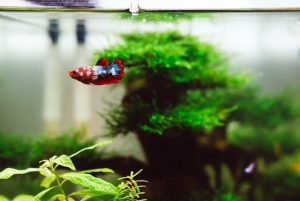The Art of Betta Fish Care: A Comprehensive Guide
Betta fish, often known as Siamese fighting fish, are renowned for their vibrant colours, dramatic fin displays, and captivating personalities. These beautiful aquatic creatures have not only caught the eye of aquarists but have also become popular pets among enthusiasts worldwide.
Their elegant presence in a well-maintained aquarium can be a source of joy and fascination. However, as with any pet, betta fish require more than just a tank and water; they demand proper care and attention to thrive in captivity.
In this comprehensive guide, we’ll delve into the world of betta fish care, answering your questions and offering insights into creating a happy and healthy home for your betta companion.
Betta Fish Basics
Before we dive into the nitty-gritty of betta fish care, let’s start with the basics. Betta fish have their roots deeply embedded in the heart of Southeast Asia, particularly Thailand. It is within this lush and tropical region that these captivating aquatic creatures have thrived for centuries. Their natural habitat consists of a mosaic of slow-moving waters, including rice paddies, tranquil ponds, and serene canals, all brimming with life and colour.
What sets betta fish apart and makes them an enduring favourite among aquarists is their enchanting variety of colours and mesmerizing fin shapes. These aquatic gems exhibit an unparalleled spectrum of hues, ranging from fiery reds, vibrant blues, and iridescent greens to striking blacks and pure whites.
Each betta seems to wear a unique tapestry of colours, akin to a living work of art. It’s this kaleidoscope of colours that immediately draws admirers and captures the imagination of aquarists, making betta fish the quintessential choice for those seeking a dash of natural splendour within the confines of an aquarium.
Betta Fact #1: Origin and Habitat
Betta fish hail from the tropical waters of Thailand, Cambodia, Laos, and Vietnam. Understanding their natural habitat is crucial for providing the best possible care in captivity. In the wild, bettas endure monsoon seasons, which can cause extreme changes in water conditions. Their ability to adapt to different water parameters is proof of their hardiness.
Betta Fact #2: Common Varieties
There are several betta fish varieties, each with its unique characteristics and allure. The most common varieties include Crowntails, Halfmoons, and Plakats, each with distinct fin shapes and patterns. The dazzling array of colours and fin variations is a testament to the fascinating world of betta genetics.
Setting Up the Ideal Betta Habitat
Creating the right environment for your betta is essential for their well-being. Consider these key elements:
Selecting the Right Tank
Start with an appropriately sized tank. Betta fish are solitary by nature, and a tank of around 5-10 gallons is ideal for a single betta. Make sure it has a secure lid to prevent jumping, as bettas are known to be excellent jumpers.
Water Conditions and Temperature
Maintaining the correct water conditions is important to their sustainability. Betta fish thrive in slightly acidic water with a temperature between 78-80°F (25-27°C). A heater and thermometer are essential for regulating the water temperature, ensuring that your betta remains comfortable and healthy.
Aquarium Decorations and Plants
Betta fish appreciate a well-decorated tank. Use silk or live plants to provide hiding spots and simulate their natural habitat. Bettas enjoy exploring their surroundings and can become stressed if they feel exposed. Providing plenty of hiding places can help alleviate this.
Turning Off the Betta Light at Night
Providing your betta with a consistent day-night rhythm is essential for their well-being, and this includes giving them periods of darkness for rest.
- Benefits of a Day-Night Cycle: Like all animals, bettas have evolved to follow natural day-night cycles. A consistent cycle helps regulate their behaviour and promotes overall well-being. Betta fish are diurnal creatures, exhibiting peak activity during the day while resting at night. Turning off the tank light at night mimics their natural environment and allows them to rest peacefully.
- Creating a Suitable Environment: A well-designed aquarium should include a timer for the tank light, allowing you to establish a consistent lighting schedule. It’s recommended to provide around 10-12 hours of light during the day and 10-12 hours of darkness at night. This balanced cycle supports your betta’s natural behaviour and contributes to their overall health and happiness.
Betta Fish Behaviour and Enrichment
Bettas are generally solitary in the wild, and when kept in captivity, it’s essential to house them alone or with compatible tankmates. Understanding which fish species can coexist harmoniously with bettas is vital to providing a suitable environment.
Understanding Betta Fish Behaviour
Bettas are known for their aggressive tendencies, especially towards other males. They are highly territorial creatures. While bettas can coexist with some fish species, it’s essential to research and select tankmates carefully. For instance, breeding Tetras at home can provide suitable companions for bettas but carefully monitor their interactions to ensure a harmonious environment. If any signs of aggression or stress arise, it’s best to separate the fish to prevent injury.
Providing Mental Stimulation and Enrichment
To keep your betta engaged and mentally stimulated, consider adding a mirror to the tank temporarily or placing it near another betta for a short time. This can provide mental stimulation without the risk of physical harm. Additionally, providing hiding spots and rearranging decorations periodically can encourage exploration and prevent boredom.
Are Betta Fish Smart?
While they may not rival dolphins in terms of intelligence, betta fish exhibit surprising levels of cognition. They can recognize their owners, respond to stimuli, and even display territorial behaviour. A study suggested that they may have a rudimentary ability to learn, focus and remember.
Keeping Your Betta Happy
The key to a happy betta is a well-maintained habitat, a balanced diet, and social interaction. Regularly interact with your betta and observe their behaviour. A happy betta is more vibrant and active. Spend time watching and appreciating their graceful movements and vibrant colours. If your betta starts displaying unusual behaviour or shows signs of distress, it’s essential to investigate and address the issue promptly.
Feeding Your Betta
A well-balanced diet is basic to your betta’s health and wellness. Betta fish are carnivorous and require a protein-rich diet.
Types of Betta Fish Food
Betta fish enjoy a variety of foods, including high-quality betta pellets, frozen or live brine shrimp, and bloodworms. Rotating their diet helps ensure they receive essential nutrients and prevents dietary boredom. Some betta enthusiasts even experiment with breeding Tetras at home to provide live food as a nutritional supplement.
Feeding Schedule
Feed your betta two to three small meals a day. Only provide what they can consume within a few minutes to avoid overfeeding, which can lead to obesity and health problems.
Live vs. Dry Food
These species love a variety of food, per a study from the University of Southern Maine. While live food can be a valuable addition to their diet, high-quality dry foods can also offer excellent nutrition. Commercial betta pellets are specially formulated to meet their dietary needs and can be a convenient and balanced staple.
Regular Tank Maintenance
Maintaining a clean and healthy environment is central to preventing common health issues in bettas.
- Cleaning the Tank: Regularly clean the tank by removing uneaten food, waste, and debris from the substrate. Use a siphon or gravel vacuum to clean the gravel and perform partial water changes. Cleaning not only helps maintain water quality but also prevents the buildup of harmful substances like ammonia and nitrites.
- Inspecting Equipment: Regularly inspect the equipment in your aquarium, such as the filter, heater, and lighting. Ensure that they are functioning correctly and that there are no visible signs of damage or malfunction. Properly functioning equipment contributes to a stable and healthy environment for your betta.
The Importance of Water Changes
Regular water changes are the cornerstone of maintaining good water quality in your betta’s tank. Clean water is essential for the overall health and well-being of your fish.
- Performing Water Changes: Performing regular water changes helps keep ammonia and nitrite levels in check. It’s generally recommended to conduct a 25-30% water change on a weekly basis. During water changes, use a water conditioner to remove chlorine and chloramines from tap water, and ensure that the replacement water matches the temperature and parameters of the existing tank water. Sudden changes in water conditions can stress bettas, so gradual changes are preferable.
- Benefits of Water Changes: Water changes also help dilute toxins, remove excess nutrients, and replenish essential minerals. They promote a stable pH level and maintain a healthy nitrogen cycle in the aquarium. Consistent water changes are vital for reducing the risk of stress-related diseases and maintaining the vitality of your betta.
Filter and Water Maintenance
A gentle filter is essential to keep the water clean and oxygenated. Regularly monitor water parameters using a test kit and perform partial water changes to maintain water quality. Proper filtration and water changes are vital for preventing the buildup of harmful substances such as ammonia and nitrites.
Typical Health Concerns and How to Deal with Them
While betta fish are known for their hardiness, they are not immune to health issues. Being vigilant and proactive in recognizing and addressing these issues is essential for ensuring the well-being of your betta companion.
Betta Health Issues: Fin Rot and Ich
Two common health problems that bettas may encounter are fin rot and ich. Fin rot is characterized by the deterioration of the fins and tail, which can manifest as frayed or discoloured edges. Ich, on the other hand, presents as white spots resembling grains of salt on the fish’s body and fins. Both conditions can be caused by stress, poor water quality, or exposure to pathogens.
- Symptoms and Recognition: Recognizing the symptoms of these health issues fast is necessary. Watch for torn or discoloured fins, white spots, changes in behaviour (such as reduced activity or loss of appetite), or any signs of distress. A healthy betta should have vibrant colours, erect fins, and be active and alert.
- Appropriate Treatments: Having appropriate treatments on hand is vital in case your betta falls ill. Treatments like aquarium salt and medications designed for bettas can be used to address these conditions. It’s essential to follow the instructions carefully and to quarantine any sick bettas in a separate tank to prevent the spread of illness to other fish in the aquarium.
Monitoring Fin and Tail Condition
Keep a vigilant eye on the condition of your betta’s fins and tail. Any tears, damage, or signs of deterioration should be addressed promptly. Damaged fins can make bettas more susceptible to infections and may affect their swimming ability. To promote healing, maintain excellent water quality and consider adding stress-reducing agents like Indian almond leaves to the tank.
Photo by Huy Phan from Unsplash
Conclusion
In conclusion, betta fish make wonderful and captivating pets when provided with the proper care and environment. By understanding their needs, maintaining their habitat, and offering a balanced diet, you can ensure your betta fish thrives and lives a happy, healthy life. Remember that responsible pet ownership is about fostering a strong bond with your betta companion.
Thanks to Christine Parker from japanesefightingfish.org for this wonderful guest blog. Be sure to check out the link for a wealth of fishkeeping resources!
To read our other blogs, click here! Or, to browse HugglePets’ products, click here! And for any questions, queries, or concerns, contact us on Facebook.






